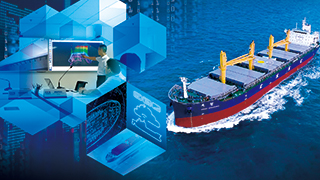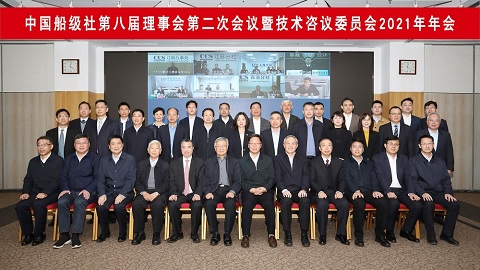Among the available green fuels, methanol and green ammonia are considered the two main stream alternative fuels for achieving net zero emissions in international shipping by virtue of their good supply and economic expectations.
By Jin Ding CCS Wuhan Rules & Research Institute

Among the available green fuels, methanol and green
ammonia are considered the two main stream alternative fuels for achieving net
zero emissions in international shipping by virtue of their good supply and
economic expectations. So, what are the corresponding requirements for the use
of ammonia fuel in ships at present? Is the green ammonia preparation
technology mature, and what are its future development prospects?
Green Fuel Standards and
Certification
China Classification Society (CCS) released the
"Guidelines for Ships Using Ammonia Fuel" in 2022. In addition, major
classification societies around the world have also introduced the rules for
ammonia-fueled vessels.
After three years, the International Maritime
Organization (IMO) finalized the "Interim Safety Guidelines for Ships
Using Ammonia Fuel" (draft) in 2024, which is expected to be officially
adopted in December 2024. The design and construction of ammonia-fueled vessels
will usher in recognized international regulations. For ammonia carriers that
use cargoes as fuels, IMO has also revised the IGC rules to allow some toxic
cargoes to be used as ship fuels. Relevant technical requirements are being
formulated, and soon the problem of shortage of rules will also be solved for
ammonia carriers that use cargoes as fuels.
The European Union has proposed regional green fuel
standards in the Renewable Energy Directive, which categorize green fuels into
three types: Renewable fuels of non-biological origin (RFNBO), Recycled carbon
fuels (RCF), and biomass fuels. These standards are applicable to shipping
green ammonia fuels and set requirements for green fuels in terms of carbon
source, hydrogen source, energy source, emission intensity, sustainability,
etc.
In addition to meeting the requirements of green fuel
standards, the fuels produced must also be certified as green fuel by qualified
institutions in accordance with the certification system recognized by the
European Commission that meets the requirements of the Renewable Energy
Directive before it can be considered green fuel. Currently, there are many
certification systems or mechanisms that comply with the requirements of the EU
Renewable Energy Directive, among which ISCC (International Sustainability
& Carbon Certification) EU is one of the most widely used. ISCC EU is one
of the categories of the ISCC certification system, which proposes basic
requirements for sustainable/green fuels from three aspects of sustainability
requirements, traceability and regulatory chain, and greenhouse gas emissions.
Green Ammonia Preparation
Unlike carbon-containing fuels such as methanol that
has two ways of preparation: biomass preparation and electrosynthesis, ammonia,
as a zero carbon fuel, currently has only one feasible preparation method, that
is electrosynthesis. Traditional fossil-synthesized ammonia is prepared by the
Haber-Bosch Process, which catalyzes nitrogen and hydrogen to produce ammonia
under high temperature and pressure conditions. During the process, the
high-temperature and high-pressure environment is provided by fossil fuels,
resulting in a high greenhouse gas emission intensity throughout the entire
lifecycle of the final product. Green ammonia is produced by electrolyzing
water with renewable energy sources, and the energy required for the reaction
is provided by renewable energy sources. Compared with the traditional
preparation methods, changing the energy source can achieve the preparation of
green ammonia. The preparation technology of ammonia is extremely mature, and
the technological breakthroughs will mainly be made in reducing reaction
conditions and improving reaction yields in the future, but the preparation
method will not undergo significant changes.
In terms of the compliance of green fuels, two factors
are mainly considered: sustainability and emission intensity.
1. For green ammonia, its molecular formula does not
contain carbon and it is generally not prepared by biomass process. There is
currently no disagreement on the sustainability of its hydrogen and nitrogen
sources. Therefore, whether the ammonia produced can be certified as green
ammonia mainly depends on its greenhouse gas emissions throughout its entire
lifecycle.
2. In the EU Renewable Energy Directive, the full
lifecycle greenhouse gas emission intensity is 28.2CO2eq/MJ (70% lower than
fossil fuels) for RFMBO and RCF. According to the calculation results of US
Greet software, if renewable energy is used for power supply, the full
lifecycle greenhouse gas emission intensity of ammonia is 2.13gCO2eq/MJ; if
coal-fired boiler is used for energy supply, the full lifecycle greenhouse gas
emission intensity of ammonia is 17.08 gCO2eq/MJ. Whether energy supply is
provided by renewable energy or coal-fired boilers, the full lifecycle
greenhouse gas emission intensity of electro-synthetic ammonia can meet the
requirement of reduction by 70%. Considering that some of the built-in energy
consumption and production efficiency parameters in Greet software are set
based on the technological level of the United States, for
domestically-produced green ammonia, under the same preparation method, its
full lifecycle emission intensity is usually higher than the calculated value
of the software, which may exceed 28.2CO2eq/MJ.

Comprehensive Adaptability
Analysis
To assess the comprehensive adaptability of ship
fuels, key factors such as emission reduction contribution, technology
maturity, fuel availability, economy, etc should be considered.
1. Contribution to Emission Reduction
From the perspective of ship side, as ammonia is a
zero-carbon fuel, carbon emissions will not be produced after its complete
combustion. However, the net zero emissions of the shipping industry focus on
the full lifecycle, and although ammonia does not contain carbon, carbon
emissions are generated during its production (upstream) and transportation
(midstream) process. But if renewable energy is used to synthesize green
hydrogen and nitrogen to produce green ammonia, significant emissions reduction
can be achieved to fully meet the requirements of international regulations for
green fuels.
2. Technology Maturity
Technically speaking, the storage, transportation, and
supply of ammonia are relatively mature, but currently the biggest problem is
internal combustion engines running on ammonia fuel. Based on the current
situation, ammonia internal combustion engines are still at the initial stage
of development, with both MAN ES and W?rtsil? carrying out R&D. Mainstream
domestic engine manufacturers have also developed the R&D plans. After
nearly 3 years, significant progress has been made in the R&D of internal
combustion engines using ammonia fuel, especially in the R&D of low-speed
two-stroke and medium-speed four-stroke ammonia engines. Commercial ammonia
engine products will be put into the market by the end of this year or early
next year, and there will be more types of marine ammonia engines in the
future.
3. Fuel Availability
As for ammonia fuel, the availability of green ammonia
is a major concern for the shipping industry. According to statistics from the
International Renewable Energy Agency (IRENA), as of November 2023, the global
planned production capacity of green ammonia has exceeded 70 million tons,
which is mainly distributed in Australia, the Middle East, Africa, etc.
Currently, there is no green ammonia production in China. According to
statistics from China Classification Society (CCS), the planned production
capacity of green ammonia in China is about 9.5 million tons, which has begun
to take shape and is still growing rapidly. With the increasingly strict
emissions reduction regulations and the rapid increase in carbon costs, the
green ammonia industry is expected to experience rapid development.
4. Economy
Currently, the production cost of green ammonia is
significantly higher than that of gray ammonia produced from fossil fuels, but
with the continuous development of renewable energy electricity, it is expected
that the cost of green hydrogen production will also decrease, and the price of
green ammonia will continue to decline. According to the International
Renewable Energy Agency (IRENA), the current global cost of producing green
ammonia through renewable resources is about $700 to $1,300 per ton. It is
expected that by 2030, the minimum cost of producing green ammonia will
decrease to $450-$900. In addition to this data, CCS has also calculated the
upper and lower limits of domestic green ammonia prices based on the
composition structure of gray ammonia price, combined with energy consumption,
cost and other information obtained from research on domestic fuel production
and transportation enterprises and bunkering ports. After calculation, the
domestic green ammonia prices are within the range of IRENA's prediction
results.
For the marine economy of green ammonia, CCS has made
acceptable price predictions for green ammonia at different time points. The
acceptable price of fuel refers to the equal economic efficiency of ships using
green ammonia fuel and traditional fuel at that price (consider paying IMO
greenhouse gas emissions tax and fuel intensity penalty for fuel). According to
the calculation results, after 2035, the economy of ships using green ammonia
will begin to be equivalent to that of ships using fuel oil. After 2045, ships
using green ammonia will generally be more economical than ships using fuel
oil.
Future Outlook
Overall, the current global and domestic production of
green ammonia is still in its early stages of development, with planned
production capacity already taking shape but actual production capacity being
limited. The production cost is also much higher than that of gray ammonia
produced from fossil fuels, and it does not yet have the economical efficiency
for marine use. In view of the progress in production technology and the
decrease in renewable energy electricity costs, it is expected that the cost of
green ammonia in China will continue to decline in the future. It is expected
that after 2035, the economical efficiency of ships using green ammonia will
begin to be equivalent or close to that of ships using fuel oil. After 2045, it
will be more economical to use green ammonia than using fuel oil for ships.
Note: If you need to reprint, please indicate the source of the information.













